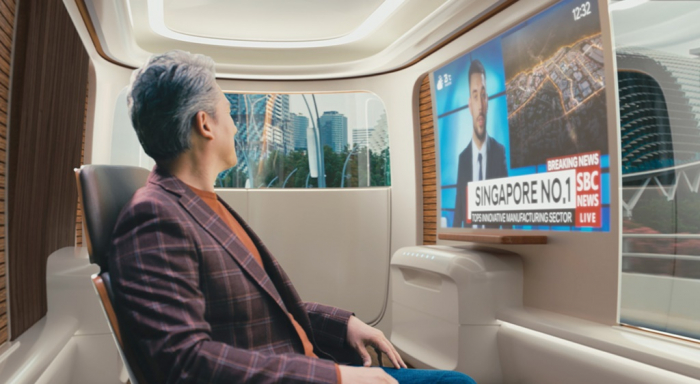Future mobility
Kia plans new Korea plant first time in 25 years for purpose-built vehicles
The unit of Hyundai Motor Group will produce four PBV models from the new factory with an aim to sell 1.5 million units
By Mar 24, 2022 (Gmt+09:00)
3
Min read
Most Read
LG Chem to sell water filter business to Glenwood PE for $692 million


Kyobo Life poised to buy Japan’s SBI Group-owned savings bank


KT&G eyes overseas M&A after rejecting activist fund's offer


StockX in merger talks with Naver’s online reseller Kream


Mirae Asset to be named Korea Post’s core real estate fund operator



Kia Corp., South Korea’s No. 2 automaker, will set up a new domestic factory for the first time in 25 years to produce purpose-built vehicles (PBVs) with an aim to become the global leader of the emerging segment by 2030.
The PBV is a self-driving ground mobility that can change into various shapes and functions depending on the purpose of customers, according to Hyundai Motor Group, to which Kia belongs. It is possible to customize not only internal and external designs but also seat arrangement and application of various electronics products.
Kia has recently explained to unionized workers the decision for a plant for future models including PBVs and pickup trucks, according to industry sources on Thursday. Kia last in 1997 added a production facility in its complex in Hwaseong, some 80 kilometers south of Seoul.
Kia and its larger automaking affiliate Hyundai Motor Co. have not increased production capacity in South Korea since 2000 as the local market has already saturated. They built plants for overseas sales. But Kia decided to build a new plant for PBVs in South Korea where the company’s core research and development base is located as the models are a new concept vehicle that has never been made before.
The company is expected to spend billions of dollars for the plant, although it has yet to decide the size of the investment.
The factory, scheduled to be completed by December 2024, is set to manufacture PBVs. It will also produce some parts of pickup trucks, which will be completed with parts made in existing plants.
TO START MASS PRODUCTION IN JULY 2025
Kia plans to start mass production of a mid-sized PBV in July 2025 used for ride-hailing and delivery services as the rapid growth in e-commerce is expected to increase demand for such a vehicle. The PBV is a level 4 autonomous driving model with an indoor height of 1.8 meters, durability of 600,000 kilometers, over-the-air update functions.
The automaker will then launch a micro unmanned PBV optimized for delivery of parcels or foods, a mid-sized robo-taxi model and a large PBV that can replace existing buses and be used as multi-seater shuttles or mobile offices. Kia aims to sell 1.5 million of those PBVs around the world.
Kia expects the global PBV market to grow 20 million units in 2030, accounting for about 30% of the global sales of new vehicles.
Its global competitors have already been targeting the market as logistics companies around the world announced plans to buy customized vehicles. General Motor Co.’s electric commercial vehicle business, BrightDrop, signed customized electric vehicle supply deals with US Walmart Inc. and FedEx Corp. BrightDrop is expected to similar models with Kia’s PBVs. Toyota Motor Corp. also showcased its fully self-driving e-Palette transportation pods during the Tokyo Olympics last year.
Last year, Kia Chief Executive Song Ho-sung expressed confidence that Kia can compete with them in an exclusive interview with The Korea Economic Daily.
“Kia can be flexible and quickly respond to customer requirements. We are already making military vehicles, a type of PBVs,” Song said. “We want to be the world’s top player in this segment.”
NEW LIVING SPACE
Hyundai Motor Group unveiled its ambition of the PBV at CES 2020 in Las Vegas.
The box-shaped vehicle is divided into the lower part that moves the body and the upper part for passengers. It has a very high utility as it can be used for such as public transportation, clinic, cafe, living space, freight transfer, etc. When PBVs are commercialized, they will be able to act as a new type of living space, Hyundai said at that time.

The group aims to add self-driving technology to PBVs, allowing customers to freely work or watch movies instead of driving. It also plans to set up docking stations in the future that can connect several PBVs.
A combination of various types of PBVs is expected to create a new complex, a Hyundai Motor Group official said. For example, it is possible to establish a general hospital with the connection of medical PBVs and set up a cultural complex with PBVs for cafes and exhibitions.
Write to Il-Gue Kim and Byung-Uk Do at black0419@hankyung.com
Jongwoo Cheon edited this article.
More to Read
-
 Electric vehiclesKia aims to launch 14 all-electric models by 2027
Electric vehiclesKia aims to launch 14 all-electric models by 2027Mar 03, 2022 (Gmt+09:00)
3 Min read -
 Chief ExecutivesKia aims to become purpose-built vehicle market leader: CEO
Chief ExecutivesKia aims to become purpose-built vehicle market leader: CEOFeb 02, 2021 (Gmt+09:00)
4 Min read
Comment 0
LOG IN


